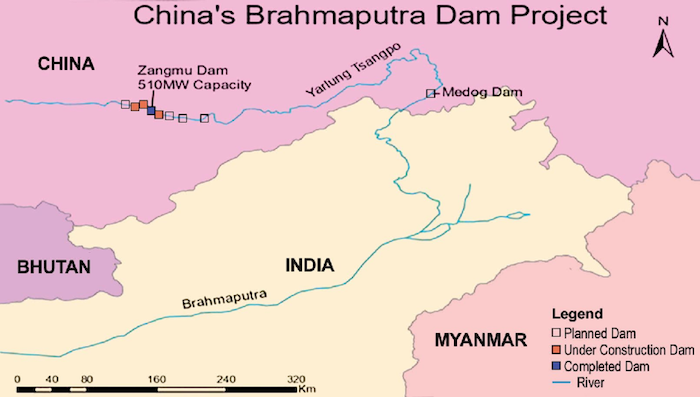China has announced plans to build the world’s largest hydropower dam on the Yarlung Zangbo (Tsangbo) River in the Tibetan Plateau.
The move is controversial, as it could affect tens of millions of people downstream in India and Bangladesh, where it is known as the Brahmaputra. India warned in 2020 it would be forced to build a 10 gigawatt hydro dam in its remote eastern state of Arunachal Pradesh if China went ahead with such a project in Tibet.
The dam, to be located in the lower reaches of the Yarlung Zangbo, will also be expensive – it could cost $40 billion. But China’s Power Construction Corp has claimed it could generate an incredible 300 billion kilowatt-hours of electricity annually.
ALSO SEE: China Plans Record $411 Billion Bond Issuance in 2025: Sources
That would be more than three times the 88.2 billion kWh designed capacity of the Three Gorges Dam, currently the world’s largest, in central China.
The project will play a major role in meeting China’s carbon peaking and carbon neutrality goals, stimulate related industries such as engineering, and create jobs in Tibet, the official Xinhua news agency reported on Wednesday.
A section of the Yarlung Zangbo falls a dramatic 2,000 metres (6,561 feet) within a short span of 50 km (31 miles), offering huge hydropower potential, as well as unique engineering challenges.
The outlay for building the dam, including engineering costs, is also expected to eclipse the Three Gorges dam, which cost 254.2 billion yuan ($34.83 billion). This included the resettling of the 1.4 million people it displaced and was more than four times the initial estimate of 57 billion yuan.
Authorities have not indicated how many people the Tibet project would displace and how it would affect the local ecosystem, one of the richest and most diverse on the plateau.
But according to Chinese officials, hydropower projects in Tibet, which they say hold more than a third of China’s hydroelectric power potential, would not have a major impact on the environment or on downstream water supplies.
One reason why the huge dam project has been given a green light is likely to be linked to the thousands of new jobs it would create, given concern recently over the country’s high youth unemployment rate and economic slowdown.

‘Weaponizing transboundary rivers’
India and Bangladesh have, as sad, raised concerns about all dams China is building on the Yarlung Zangbo, because they have the potential to alter not only the local ecology but also the flow and course of the river downstream.
Some 70% of Bangladesh’s population is said to live in the Brahmaputra basin.
Scholars have accused the Chinese of “weaponizing” its water resources in Tibet, saying in a paper in March this year: “China’s control over water flow presents a substantial concern for lower riparian states, as it holds the potential to affect water security, economic development, environmental stability, and geopolitical relations.
“Such control could adversely impact the water security of these states.”

Jayantha Dhanapala, a former UN undersecretary-general, has said China’s “water diplomacy” is often viewed as coercive and raises suspicions about China’s intentions.
Vietnam and India have both accused China of leveraging its water resources to exert political pressure. Vietnam “alleges that China’s construction of dams on the Mekong River aims to divert water away from Vietnam, while India accuses China of building dams on the Brahmaputra River to diminish water flow into India,” Neeraj Manhus and Dr Rahul Lad said.
China regards transboundary rivers as “sovereign resources within its jurisdiction, to be utilized as it sees fit,” they said. And it “perceives international water conventions and legally binding treaties concerning transboundary rivers as contrary to its national interests and sovereignty.”
China refuses to sign convention on international rivers
Beijing, they said, had refused to sign the UN Convention on the Law of the Non-Navigational Uses of International Watercourses in 1997, which aims to establish norms for cooperation and management of transboundary rivers among riparian countries based on principles of mutual benefit and cooperation.
China’s hydrological dominance over these rivers prompts debate over whether its actions are detrimental or beneficial, particularly regarding the Mekong and the Yarlung Tsangpo.
The Yarlung Zangbo becomes the Brahmaputra river as it leaves Tibet and flows south into India’s Arunachal Pradesh and Assam states and finally into Bangladesh.
China began building hydropower dams on the upper reaches of the Yarlung Zangbo in 2015, which flows from the west to the east of Tibet.
But a new concern regarding the latest proposal is that China may be planning to divert water that would normally end up flowing through India and Bangladesh to a multi-decade grand plan to transfer water to the Gobi Desert.
Manhaus and Lad said “the proposed western route of the South-North Water Transfer Project aims to transfer water from the Yangtze River in southern China to the Gobi Desert in the north. Construction of the project’s east and central canals has already commenced, with the completion of all three channels anticipated by 2050.
“The potential involvement of the Brahmaputra River in this project raises concerns about its impact on downstream water availability in India and Bangladesh,” they said.
“Despite sharing the major transboundary river, the Brahmaputra, India and China lack a formal water-sharing agreement, exacerbating worries and uncertainties surrounding China’s dam construction activities.”
- Jim Pollard with Reuters
ALSO SEE:
Climate Change Has Cost China $32 Billion in Just One Quarter
World’s Second-Biggest Hydro Plant Starts in China – Yicai
China Planning Huge Water Projects to Counter Drought, Floods
China Plans Mammoth Tunnel To Ship Water to Beijing – SCMP
China Using 3D Printing to Build Tibet Dam – SCMP
Power Plants in Three Gorges Sold to China Yangtze For $12bn
China Seeks Better Adaptation to Climate Change As Risks Rise
China’s Brahmaputra Dam Plan May Make India Build One Too
China Frets on Cost of Climate Change
China bid to boost GDP with $142 bn of water projects
























